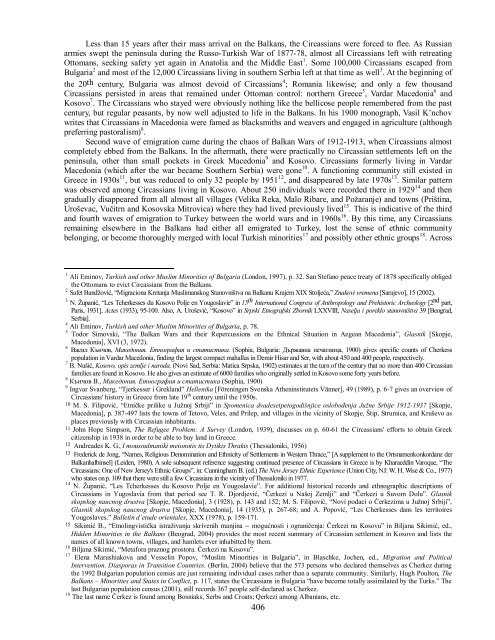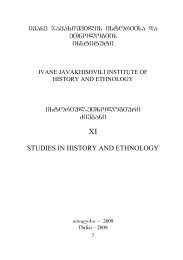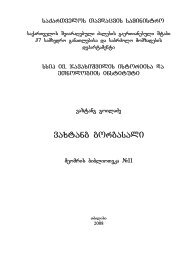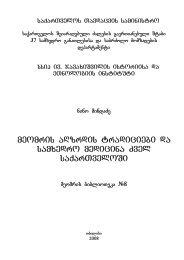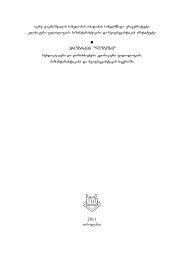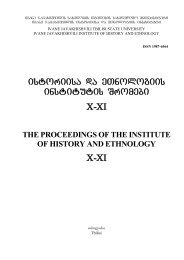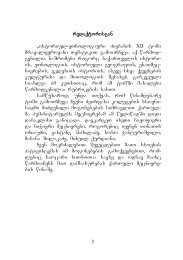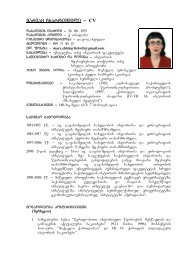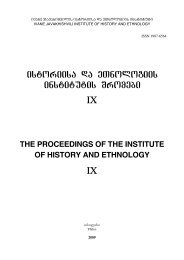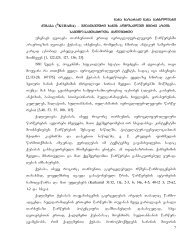axali da uaxlesi istoria
axali da uaxlesi istoria
axali da uaxlesi istoria
You also want an ePaper? Increase the reach of your titles
YUMPU automatically turns print PDFs into web optimized ePapers that Google loves.
Less than 15 years after their mass arrival on the Balkans, the Circassians were forced to flee. As Russian<br />
armies swept the peninsula during the Russo-Turkish War of 1877-78, almost all Circassians left with retreating<br />
Ottomans, seeking safety yet again in Anatolia and the Middle East 1 . Some 100,000 Circassians escaped from<br />
Bulgaria 2 and most of the 12,000 Circassians living in southern Serbia left at that time as well 3 . At the beginning of<br />
the 20th century, Bulgaria was almost devoid of Circassians 4 ; Romania likewise; and only a few thousand<br />
Circassians persisted in areas that remained under Ottoman control: northern Greece 5 , Var<strong>da</strong>r Macedonia 6 and<br />
Kosovo 7 . The Circassians who stayed were obviously nothing like the bellicose people remembered from the past<br />
century, but regular peasants, by now well adjusted to life in the Balkans. In his 1900 monograph, Vasil K’nchov<br />
writes that Circassians in Macedonia were famed as blacksmiths and weavers and engaged in agriculture (although<br />
preferring pastoralism) 8 .<br />
Second wave of emigration came during the chaos of Balkan Wars of 1912-1913, when Circassians almost<br />
completely ebbed from the Balkans. In the aftermath, there were practically no Circassian settlements left on the<br />
peninsula, other than small pockets in Greek Macedonia 9 and Kosovo. Circassians formerly living in Var<strong>da</strong>r<br />
Macedonia (which after the war became Southern Serbia) were gone 10 . A functioning community still existed in<br />
Greece in 1930s 11 , but was reduced to only 32 people by 1951 12 , and disappeared by late 1970s 13 . Similar pattern<br />
was observed among Circassians living in Kosovo. About 250 individuals were recorded there in 1929 14 and then<br />
gradually disappeared from all almost all villages (Velika Reka, Malo Ribare, and Požaranje) and towns (Priština,<br />
Uroševac, Vučitrn and Kosovska Mitrovica) where they had lived previously lived 15 . This is indicative of the third<br />
and fourth waves of emigration to Turkey between the world wars and in 1960s 16 . By this time, any Circassians<br />
remaining elsewhere in the Balkans had either all emigrated to Turkey, lost the sense of ethnic community<br />
belonging, or become thoroughly merged with local Turkish minorities 17 and possibly other ethnic groups 18 . Across<br />
1 Ali Eminov, Turkish and other Muslim Minorities of Bulgaria (London, 1997), p. 32. San Stefano peace treaty of 1878 specifically obliged<br />
the Ottomans to evict Circassians from the Balkans.<br />
2 Safet Bandžović, “Migraciona Kretanja Muslimanskog Stanovništva na Balkanu Krajem XIX Stoljeća,” Znakovi vremena [Sarajevo], 15 (2002).<br />
3 N. Županić, “Les Tcherkesses du Kosovo Polje en Yougoslavie” in 15 th International Congress of Anthropology and Prehistoric Archeology [2 nd part,<br />
Paris, 1931], Actes (1933), 95-100. Also, A. Urošević, “Kosovo” in Srpski Etnografski Zbornik LXXVIII, Naselja i poreklo stanovništva 39 [Beograd,<br />
Serbia].<br />
4 Ali Eminov, Turkish and other Muslim Minorities of Bulgaria, p. 78.<br />
5 Todor Simovski, “The Balkan Wars and their Repercussions on the Ethnical Situation in Aegean Macedonia”, Glasnik [Skopje,<br />
Macedonia], XVI (3, 1972).<br />
6 Васил Кънчов, Македония. Етнография и статистика. (Sophia, Bulgaria: Държавна печатница, 1900) gives specific counts of Cherkess<br />
population in Var<strong>da</strong>r Macedonia, finding the largest compact mahallas in Demir Hisar and Ser, with about 450 and 400 people, respectively.<br />
7 В. Nušić, Kosovo, opis zemlje i naro<strong>da</strong>. (Novi Sad, Serbia: Matica Srpska, 1902) estimates at the turn of the century that no more than 400 Circassian<br />
families are found in Kosovo. He also gives an estimate of 6000 families who originally settled in Kosovo some forty years before.<br />
8 Кънчов В., Македония. Етнография и статистика (Sophia, 1900)<br />
9 Ingvar Svanberg, “Tjerkesser i Grekland” Hellenika [Föreningen Svenska Atheninstitutets Vänner], 49 (1989), p. 6-7 gives an overview of<br />
Circassians' history in Greece from late 19 th century until the 1950s.<br />
10 M. S. Filipović, “Etničke prilike u Južnoj Srbiji” in Spomenica dvadesetpetogodišnjice oslobođenja Južne Srbije 1912-1937 [Skopje,<br />
Macedonia], p. 387-497 lists the towns of Tetovo, Veles, and Prilep, and villages in the vicinity of Skopje, Štip, Strumica, and Kruševo as<br />
places previously with Circassian inhabitants.<br />
11 John Hope Simpson, The Refugee Problem: A Survey (London, 1939), discusses on p. 60-61 the Circassians' efforts to obtain Greek<br />
citizenship in 1938 in order to be able to buy land in Greece.<br />
12 Andreades K. G., I mousoulmaniki meionotis tis Dytikis Thrakis (Thessaloniki, 1956)<br />
13 Frederick de Jong, “Names, Religious Denomination and Ethnicity of Settlements in Western Thrace,” [A supplement to the Ortsnamenkonkor<strong>da</strong>nz der<br />
Balkanhalbinsel] (Leiden, 1980). A sole subsequent reference suggesting continued presence of Circassians in Greece is by Kharaeddin Varoque, “The<br />
Circassians: One of New Jersey's Ethnic Groups”, in: Cunningham B. (ed.) The New Jersey Ethnic Experience (Union City, NJ: W. H. Wise & Co., 1977)<br />
who states on p. 109 that there were still a few Circassians in the vicinity of Thessaloniki in 1977.<br />
14 N. Županić, “Les Tcherkesses du Kosovo Polje en Yougoslavie”. For additional historical records and ethnographic descriptions of<br />
Circassians in Yugoslavia from that period see T. R. Djordjević, “Čerkezi u Našoj Zemlji” and “Čerkezi u Suvom Dolu”. Glasnik<br />
skopskog naucnog drustva [Skopje, Macedonia], 3 (1928), p. 143 and 152; M. S. Filipović, “Novi po<strong>da</strong>ci o Čerkezima u Južnoj Srbiji”,<br />
Glasnik skopskog naucnog drustva [Skopje, Macedonia], 14 (1935), p. 267-68; and A. Popović, “Les Cherkesses <strong>da</strong>ns les territoires<br />
Yougoslaves.” Bulletin d’etude orientales, XXX (1978), p. 159-171.<br />
15 Sikimić B., “Etnolingvistička istraživanja skrivenih manjina _ mogućnosti i ograničenja: Čerkezi na Kosovu” in Biljana Sikimić, ed.,<br />
Hidden Minorities in the Balkans (Beograd, 2004) provides the most recent summary of Circassian settlement in Kosovo and lists the<br />
names of all known towns, villages, and hamlets ever inhabitted by them.<br />
16 Biljana Sikimić, “Metafora praznog prostora. Čerkezi na Kosovu”.<br />
17 Elena Marushiakova and Vesselin Popov, “Muslim Minorities in Bulgaria”, in Blaschke, Jochen, ed., Migration and Political<br />
Intervention. Diasporas in Transition Countries. (Berlin, 2004) believe that the 573 persons who declared themselves as Cherkez during<br />
the 1992 Bulgarian population census are just remaining individual cases rather than a separate community. Similarly, Hugh Poulton, The<br />
Balkans – Minorities and States in Conflict, p. 117, states the Circassians in Bulgaria “have become totally assimilated by the Turks.” The<br />
last Bulgarian population census (2001), still records 367 people self-declared as Cherkez.<br />
18 The last name Čerkez is found among Bosniaks, Serbs and Croats; Qerkezi among Albanians, etc.<br />
406


